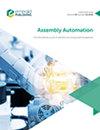非晶平面空对地无线自组织网络系统的分布鲁棒H∞自适应容错控制
IF 1.7
4区 计算机科学
Q3 AUTOMATION & CONTROL SYSTEMS
引用次数: 4
摘要
目的本文以空地一体化无线自组织网络集成系统为研究对象,旨在提出一种适合系统分布的分布式鲁棒H∞自适应容错控制算法,以同时解决控制和通信故障的问题。设计/方法/途径本文提出了一种适用于空地一体化无线自组织网络集成系统的分布式鲁棒H∞自适应容错控制算法。结果表明,该集成系统在面临外部干扰、内部执行器故障和无线网络相关故障时,对飞行控制和无线信号传输具有良好的鲁棒性和容错性能指标,四旋翼无人机的飞行控制曲线总体平稳,即使遇到外部干扰和执行器故障,其容错性能也很好。然后在400–800米的无线通信距离范围内,无线信号环路传输的成功率稳定在80%–100%,性能至少相对提高了158.823%。原创性/价值本文以空地一体化无线自组织网络集成系统为研究对象,基于鲁棒容错控制算法,提出了一种适用于该系统的分布式鲁棒H∞自适应容错控制算法,并通过Riccati方程和线性矩阵不等式方法进一步优化了故障抑制因子γ,从而突破不同故障模式只有一个李雅普诺夫矩阵分布的限制,同时解决控制和通信故障的问题。本文章由计算机程序翻译,如有差异,请以英文原文为准。
Distributed robust H∞ adaptive fault-tolerant control of amorphous and flat air-to-ground wireless self-organizing network system
Purpose
The paper takes the air-ground integrated wireless ad hoc network-integrated system as the research object, this paper aims to propose a distributed robust H∞ adaptive fault-tolerant control algorithm suitable for the system to distribute to solve the problem of control and communication failure at the same time.
Design/methodology/approach
In the paper, the authors propose a distributed robust H∞ adaptive fault-tolerant control algorithm suitable for the air-ground integrated wireless ad hoc network-integrated system.
Findings
The results show that the integrated system has good robustness and fault tolerance performance indicators for flight control and wireless signal transmission when confronted with external disturbances, internal actuator failures and wireless network associated failures and the flight control curve of the quadrotor unmanned aerial vehicle (UAV) is generally smooth and stable, even if it encounters external disturbances and actuator failures, its fault tolerance performance is very good. Then in the range of 400–800 m wireless communication distance, the success rate of wireless signal loop transmission is stable at 80%–100% and the performance is at least relatively improved by 158.823%.
Originality/value
This paper takes the air-ground integrated wireless ad hoc network-integrated system as the research object, based on the robust fault-tolerant control algorithm, the authors propose a distributed robust H∞ adaptive fault-tolerant control algorithm suitable for the system and through the Riccati equation and linear matrix inequation method, the designed distributed robust H∞ adaptive fault-tolerant controller further optimizes the fault suppression factor γ, so as to break through the limitation of only one Lyapunov matrix for different fault modes to distribute to solve the problem of control and communication failure at the same time.
求助全文
通过发布文献求助,成功后即可免费获取论文全文。
去求助
来源期刊

Assembly Automation
工程技术-工程:制造
CiteScore
4.30
自引率
14.30%
发文量
51
审稿时长
3.3 months
期刊介绍:
Assembly Automation publishes peer reviewed research articles, technology reviews and specially commissioned case studies. Each issue includes high quality content covering all aspects of assembly technology and automation, and reflecting the most interesting and strategically important research and development activities from around the world. Because of this, readers can stay at the very forefront of industry developments.
All research articles undergo rigorous double-blind peer review, and the journal’s policy of not publishing work that has only been tested in simulation means that only the very best and most practical research articles are included. This ensures that the material that is published has real relevance and value for commercial manufacturing and research organizations.
 求助内容:
求助内容: 应助结果提醒方式:
应助结果提醒方式:


